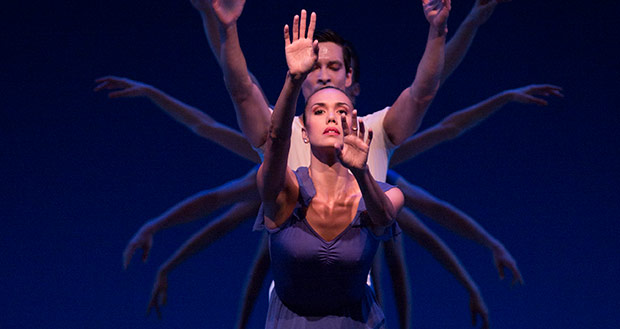
© Angela Sterling. (Click image for larger version)
Les Etés de la Danse
Homage to Jerome Robbins – Programme 2
Miami City Ballet: In the Night, Other Dances
Pacific Northwest Ballet: Opus19/The Dreamer
Perm Opera Ballet: The Four Seasons
★★★★✰
Paris, La Seine Musicale
28 June 2018
www.lesetesdeladanse.com
www.laseinemusicale.com

© Frederic Ohringer. (Click image for larger version)
The evening opened with In the Night, the second of Robbins’s ballets to Chopin’s music, created in 1970, a year after his great success with Dances at a Gathering. Three couples from Miami City Ballet performed in costumes by Anthony Dowell (presumably acquired via the Royal Ballet, which last revived In the Night in 2012.) The ballet depicts different stages in the relationships between the couples, set to orchestrated versions of Chopin’s Nocturnes.
The first pas de deux is for a youthful pair blissfully in love – Emily Bromberg and Jovani Furlan, very charming. Then comes a more mature couple in a formal setting, probably a ballroom, suggested by chandeliers on the starlit backdrop. Tricia Albertson and Rainer Krenstetter dance a restrained Polonaise as if on public view, he courteous, she a touch febrile: when he lifts her, her feet tremble with repressed emotion. Incongruously, he upends her in her full-skirted ball gown, then carries her off aloft, one knee perched on his shoulder. They evidently don’t mind who might be watching.
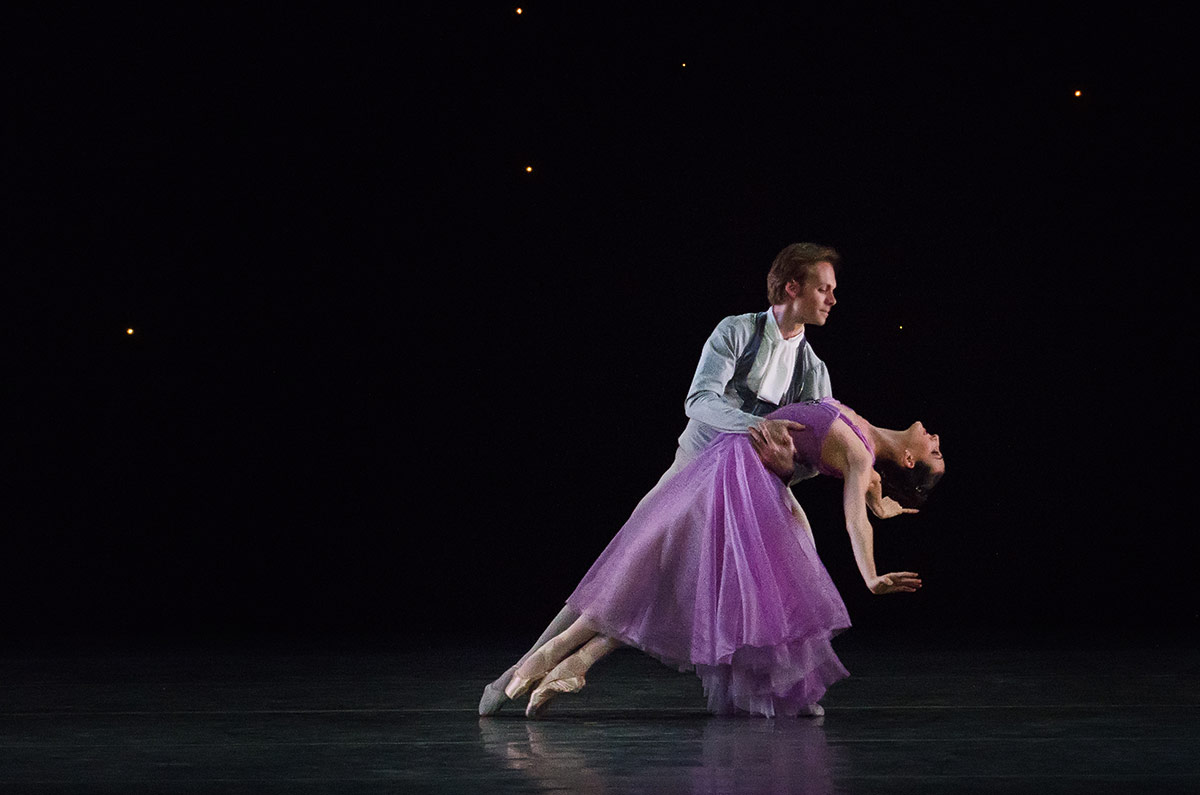
© Kyle Froman. (Click image for larger version)
The third duet is the most memorable because the woman (Katia Carranza) is tempestuous, testing the forbearance of her partner (Renato Penteado). She flings herself at him, sinks to the ground, is cradled in his arms like a child, then rejects him extravagantly. Both leave the stage in opposite directions, then return to make up. She abases herself before him, touching his body with her fingers as she pleads for forgiveness. The reconciliation seems determined by the sudden sweetness of the music rather than by the woman’s change of heart – though she is very evidently capricious.
To the fourth Nocturne, all three couples acknowledge each other before going their different ways. The brief ballet has been about the woman in each duet, and her expectations of how love should be. Their partners have been compliant porteurs, making few demands of their own. It looks as though Robbins, like Frederick Ashton, identified with the woman rather than the man.
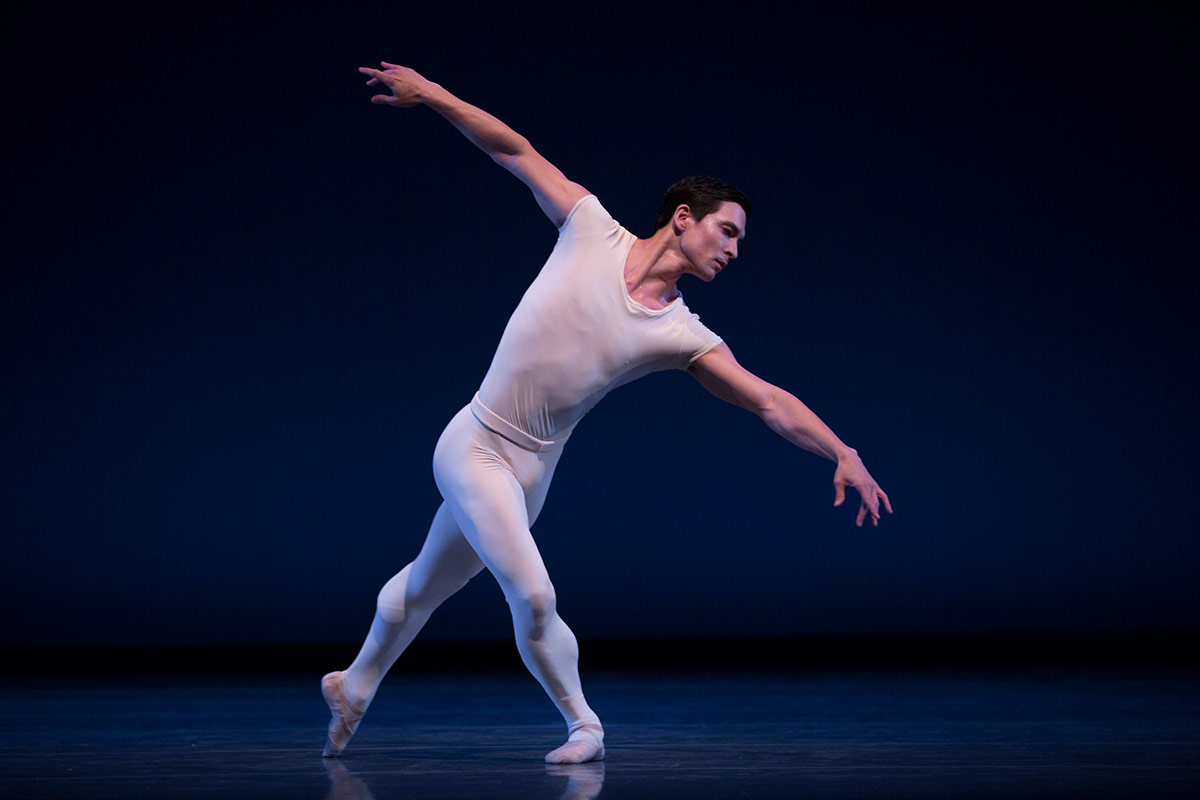
© Angela Sterling. (Click image for larger version)
Opus 19/The Dreamer is choreographed entirely from the male soloist’s point of view. Made in 1979 for New York City Ballet, with Mikhail Baryshnikov as the Dreamer, it is set to Prokofiev’s Violin Concerto no 1, opus 19. Peter Boal, who frequently danced the solo role with NYCB, took it into Pacific Northwest Ballet’s repertoire last year. He has entrusted the role to a young corps de ballet member, Dylan Wald (as well as to senior dancers), who performed it spectacularly well the night I saw it in La Seine Musicale.
Wearing white tights and T-shirt, the Dreamer has nowhere to hide. He is isolated, an outsider, reliving a half-remembered reverie that turns into a nightmare. Like the Melancholic soloist in Balanchine’s The Four Temperaments, his elegant classical line is suddenly distorted by spasms of despair. He is shadowed by a phantom corps of six men and six women who mimic his movements, the women picking their way on pointe to echo the pizzicato strings of the violin, played by Michael Jinsoo Lim.

© Angela Sterling. (Click image for larger version)
Out of their midst emerges an intimidating dark-clad woman, Sarah Richard Orza, who hurls herself at his waist, legs splayed. She demands his support, bending backwards in his arms, then parodying him as she bourrées behind him, out of reach. In the concerto’s sinister second movement, she torments him like a cruel alter-ego – the female aspect of himself that he can’t yet bring himself to accept. By the end of the scherzo, they are slumped together in an awkward embrace.
In the third movement, they appear on equal terms until she is temporarily claimed by the female phantoms, while he dances with the male contingent. When she vanishes, he is back in his own world, fumbling as though trying to retrieve his memories. He stretches out in huge arabesques, encountering invisible barriers as he twists and turns. Suddenly, she’s back. Entwined together at the end, they both shrug as the light cuts out. It’s up to us to interpret Robbins’s dream logic. Was it all a fantasy inspired by Prokofiev’s music? Was it a veiled account of his tortured sexuality and his longing for acceptance? Opus 19 is too mysterious to be an audience pleaser, though the central role is a magnificent challenge for a male dancer.
Katia Carranza and Renato Penteado in Other Dances – embedded here from Miami City Ballet’s Flickr space gallery of 2012/13 season images. Marked © Steven Caras.
Baryshnikov and Natalia Makarova were the inspiration for Other Dances in 1976. Yet again to Chopin mazurkas and waltzes, here played onstage by Miami City Ballet’s pianist, Francisco Renno, the duet is a gift for performers with strong personalities. Simone Messmer, ex-American Ballet Theatre (and briefly San Francisco Ballet) joined Miami City Ballet as a principal in 2015. Confidently she catches the impetuosity of Makarova’s role, toying with the music and trusting that her partner will be there when she needs him. Renan Cerdeiro, a principal since 2013, is more deliberate, playing down the ‘mistakes’ that Baryshnikov enjoyed, and taking his virtuoso moments seriously, before a final triumphant flourish.
Perm Opera Ballet from the Urals transformed Robbins’s The Four Seasons into a Russian romp. It is an outrageously kitsch ballet to music by Verdi, taken from I Vespri Siciliani and other operas. Hard to believe that it was made for Balanchine’s NYCB in 1979, since it’s so roguish. Perm Ballet’s painted scenery and delicious costumes are by Elena Solovyova, making a welcome change from the versions of practice dress in most of the other Robbins ballets in Les Etés de la danse. The female principals, with their Vaganova training, are more polished than the men; the corps (the ballet requires some 50 dancers in all) are less athletic than their American counterparts in the other ballets.

They are well-practised, however, at scampering and skipping and forming picturesque tableaux behind the central characters representing each season. Spring (Inna Bilash) is lissome and winsome; Summer (Albina Rangoulova) sultry and exotic; Autumn (Polina Bouldakova) is impressively hyper-supple in a send-up of a Walpurgisnacht orgy. Her partner, Nikita Chetverikov, has an easy jump and impressive turns. Autumn is plagued by a jester figure, a gambolling satyr (Taras Tovstyuk) with nimble feet (or hoofs). Winter, with its gaggle of shivering girls, closely resembles Robbins’s The Concert. He was making his show-biz version of late 19th century opera ballets, designed to titillate those patrons who turned up after dinner for the start of the third act. The Seine Musical audience loved it as an evening finale, cheering the Perm company enthusiastically.
It’s been a very enjoyable homage to Robbins’s versatility. After eight of his creations, however, I was aware of his regular resorting to folk-dance steps in ballet shoes, especially to Chopin, and the conspicuous lifts that ended most of his pas de deux as each couple exited into the wings. He over-used a lift in which the man cradles the woman in his arms like a child: sweet when relevant, but inappropriate when she’s a mature woman (even in Other Dances, for a pair of stars). All his ballets, however, are primarily about their music. The five companies in the festival brought their own conductors and solo musicians, while the resourceful Orchestre Prométhée was directed by Pierre-Michel Durand.













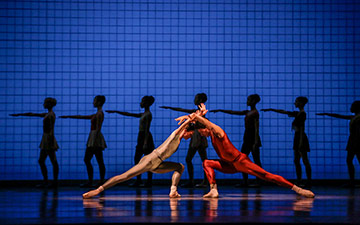
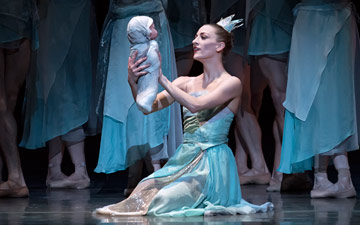


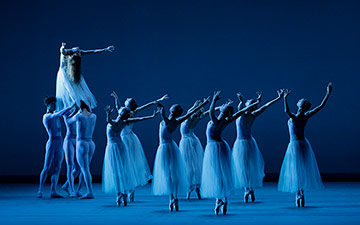
You must be logged in to post a comment.